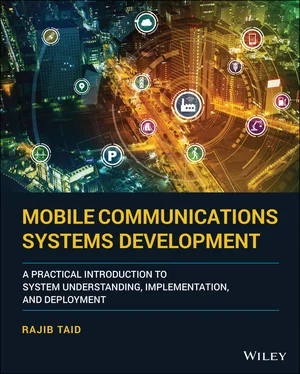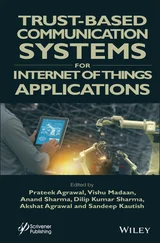7 Chapter 7 Figure 7.1 LTE/E‐UTRAN eNodeB connected to multiple core network (CN) elemen...Figure 7.2 Illustration: 5G NG‐RAN connected to multiple AMF sets.Figure 7.3 Illustration: typical MME selection and allocation to UEs using W...Figure 7.4 Illustration: core network (CN) node selection and allocation usi...Figure 7.5 Illustration: radio access network sharing and MOCN configuration...Figure 7.6 Illustration: GSM/GPRS CS/PS paging through Gs interface between ...Figure 7.7 Illustration: supporting UE signaling flow for RAN sharing throug...Figure 7.8 Illustration: non‐supporting UE signaling flow for RAN sharing th...Figure 7.9 Illustration: 5G NG‐RAN sharing through MOCN feature.
8 Chapter 8Figure 8.1 Illustration: packet encapsulation using GTP.Figure 8.2 Components of GTP user plane G‐PDU.Figure 8.3 Illustration: LTE/EPC GTP‐C message over UDP/IP interface.Figure 8.4 Illustration: GTP‐C message exchanged during inter‐RAT handover....Figure 8.5 Illustration: user data/IP packets encapsulations and tunneling u...Figure 8.6 GPRS packet encapsulation, between MS and SGSN, over the air inte...Figure 8.7 Illustration: GPRS inter SGSNs routing area update procedure.Figure 8.8 Illustration: IP header compression for a VoIP call.
9 Chapter 9Figure 9.1 Illustration: security features for protection of user traffic in...Figure 9.2 Illustration: security features for protection of signaling traff...Figure 9.3 Illustration of (a) ciphering and (b) integrity protection algori...Figure 9.4 Illustration: activation of GSM security procedure for a MOC.Figure 9.5 Illustration: LTE ciphering and integrity protection of AS and NA...Figure 9.6 Illustration: security mode command to activate ciphering and int...Figure 9.7 Illustration: LTE/EPS initial UE registration and its security fe...
10 Chapter 10Figure 10.1 Illustration: a typical alarm management system.Figure 10.2 Illustration: protocol error reporting using STATUS PDU.Figure 10.3 Illustration: LTE/EPS protocol error reporting using ESM or EMM ...Figure 10.4 Illustration: normal GTP user plane echo request and response.Figure 10.5 Illustration: An abnormal scenario in LTE/EPS: GTP alarm generat...
11 Chapter 11Figure 11.1 GSM CS voice call processing phases.Figure 11.2 Illustration: performances and optimizations management system f...Figure 11.3 Illustration: KPI various stages of a GSM call flow.Figure 11.4 Illustration: KPI areas of a network element.Figure 11.5 Illustration: KPI evaluation steps of a typical network element....Figure 11.6 Illustration: ideal and poor SLA and KPI for GSM MOC voice call....
12 Chapter 12Figure 12.1 Application and transport layer with respect to IP troubleshooti...Figure 12.2 IP packets snipping through switch port mirroring.Figure 12.3 Illustration: GSM location area update procedure.Figure 12.4 Illustration: typical UE conformance test scenarios for GSM loca...Figure 12.5 Illustration: IP packet snipping tool setup for troubleshooting ...Figure 12.6 Illustration: air interface RLC layer data throughput.
13 Chapter 13Figure 13.1 Phases of software development process and its SDLC.Figure 13.2 Illustration: embedded system development environment.Figure 13.3 Illustration: single core and multicore processor systems.Figure 13.4 Illustration: hash table and linked list of 5G UE context struct...Figure 13.5 Illustration: IPC among the processes running on Windows and UNI...Figure 13.6 Different types of signals available on the UNIX/LINUX OS.Figure 13.7 Different actions taken by a signal handler function.Figure 13.8 Illustration: typical software architecture for a GSM BSC.Figure 13.9 GSM RRM logical object model and its hierarchy.
14 Chapter 14Figure 14.1 Components of a 3GPP TS for a protocol layer.Figure 14.2 Illustration: protocol layer procedure's case value.Figure 14.3 Illustration: 5G registration request procedure with reject caus...Figure 14.4 Illustration: protocol layer procedure and its result: (a) norma...Figure 14.5 Illustration: flow of a 3GPP protocol layer procedure.Figure 14.6 Illustration: protocol layer and sublayer architecture of a logi...Figure 14.7 Illustration of various types of service primitives.Figure 14.8 Illustration: service access point (SAP) and identifier (SAPI)....Figure 14.9 Illustration: LTE/EPS peer‐to‐peer communication using PDU.Figure 14.10 Illustration: air interface Layer 3, its sublayers, and NAS lay...Figure 14.11 Classification of radio/air interface Layer 3 messages.Figure 14.12 Components of air interface Layer 3 message.Figure 14.13 Components of a non-standard Layer 3 message.Figure 14.14 GSM, GPRS, and UMTS radio/air interface Layer 3 message format....Figure 14.15 Mobile radio/air interface NAS layer message format for the LTE...Figure 14.16 Mobile air interface Layer 3 protocols identified by protocol d...Figure 14.17 GMM air interface Layer 3: DETACH REQUEST message.Figure 14.18 Air interface Layer 3: GSM RR assignment command.Figure 14.19 Illustration: LTE S1 handover preparation and resource allocati...Figure 14.20 Illustration: protocol decoding of elementary procedures messag...Figure 14.21 Illustration: LTE/EPS S1 Setup message over S1 interface.Figure 14.22 Illustration: decoding of S1 Setup Request Message protocol.Figure 14.23 Illustration of the components of a protocol layer message.Figure 14.24 Illustration of a protocol layer header part with flags. Figure 14.25 Illustration: protocol layer timer and its various states.Figure 14.26 RRC layer protocol states and its transitions: GSM/GPRS to the ...Figure 14.27 Illustration: states of a base transceiver (BTS) station.Figure 14.28 Illustration: types of protocol layer data.Figure 14.29 Illustration: LTE and 5G NR air interface protocol layer config...Figure 14.30 Illustration: various information contained in a logical contex...Figure 14.31 Illustration: padding in an IE of a message/PDU.Figure 14.32 Illustration: device driver development model.Figure 14.33 Illustration: usages of software simulator test setup for diffe...
15 Chapter 15Figure 15.1 Protocol stack for SGs logical interface between MME and MSC ser...
16 Chapter 16Figure 16.1 Illustration: 3GPP standardized 5G system use cases.Figure 16.2 Illustration: key enablers of 5GS use cases and their services....Figure 16.3 5G system network architecture.Figure 16.4 Illustration: logical architectural nodes of NG‐RAN and its use ...Figure 16.5 Illustration: control plane and user plane protocol stack of F1 ...Figure 16.6 Illustration: RRC layer signaling message flow between NG‐RAN lo...Figure 16.7 Illustration: 5GS non‐standalone deployment through EN‐DC featur...Figure 16.8 Illustration: addition of a secondary NG‐RAN/gNB node as part of...Figure 16.9 Illustration: UE single registration mode: LTE/EPS or 5G network...Figure 16.10 Illustration: UE dual registration mode: LTE/EPS and 5G network...Figure 16.11 Illustration: 5G system: network slices with standardized servi...Figure 16.12 Illustration: hierarchy of PLMN and its NSSAI.Figure 16.13 Illustration: RRC layer signaling flow for network slicing duri...Figure 16.14 Illustration: NSSAI‐based AMF selection for a network slice.Figure 16.15 Illustration: UE registration: NF signaling flow for network sl...Figure 16.16 Illustration: UE registration: NF service signaling flow for PD...Figure 16.17 Illustration: management services for management and orchestrat...Figure 16.18 Illustration: 5G NRM, its information object class, and its ass...Figure 16.19 Illustration: 5G UE security controlled by home network.Figure 16.20 Illustration: UE authentication using 5G‐AKA method through 5GC...Figure 16.21 Illustration: inter PLMN secured communication through SEPP.Figure 16.22 Illustration: conceal and de‐concealing of a UE SUPI to SUCI an...
17 Chapter 17Figure 17.1 Illustration: radio air interface protocol layer architectures o...Figure 17.2 Illustration: air interface Layer 3/NAS protocols and its catego...Figure 17.3 Illustration: air interface: AS and NAS layer signaling informat...
Читать дальше












